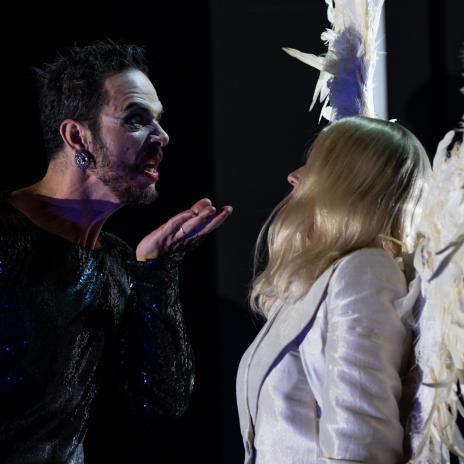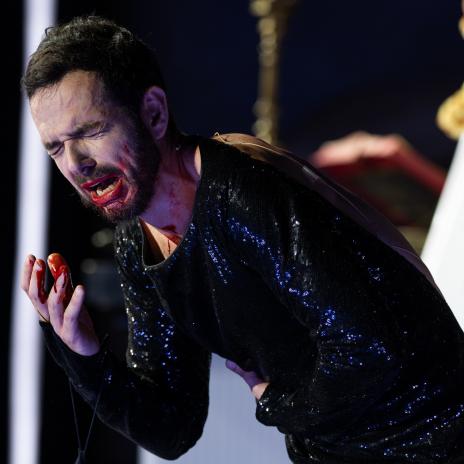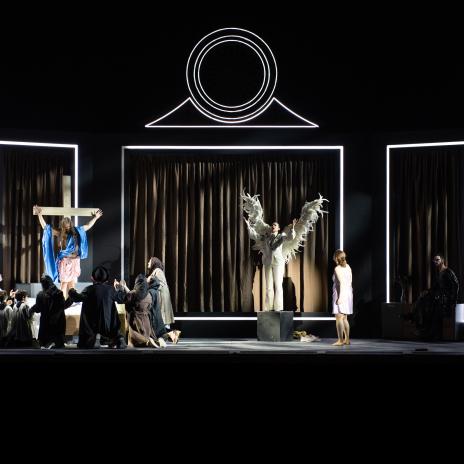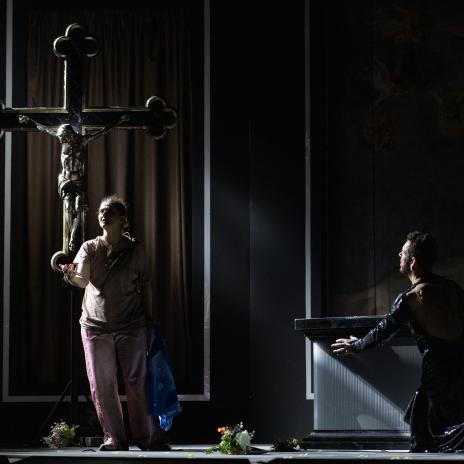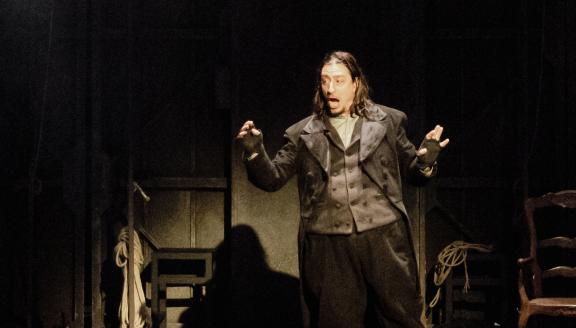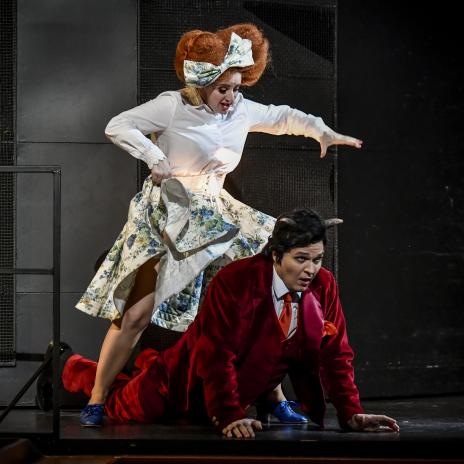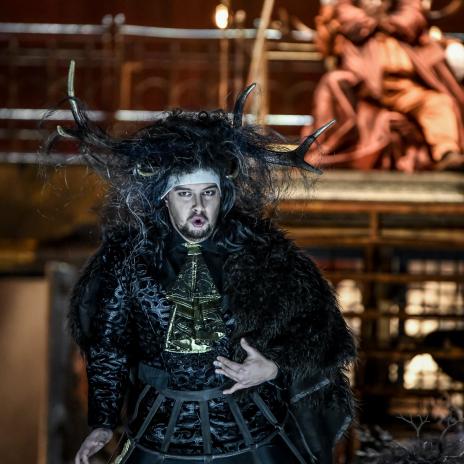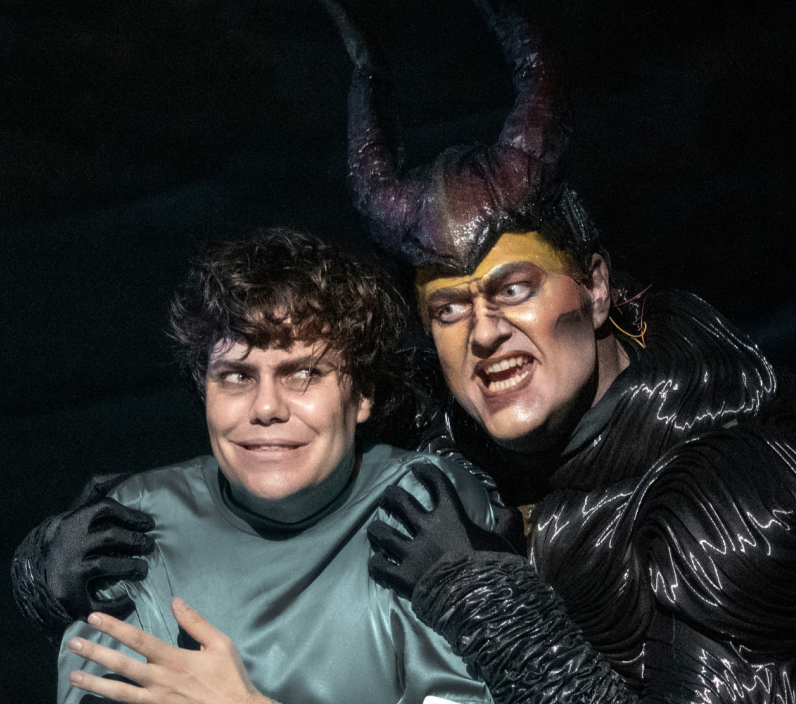
Devils in Opera
Take one human desperately in need; a devil or their proxy; and a promise that cannot be refused, such as the fulfilment of one’s innermost desires, sudden financial blessing, a love affair or eternal youth. This is how most encounters with the devil go, in stories, in literature, in the theatre and, of course, in opera. What is the catch with such agreements? Usually, the fulfilment of the pact requires the soul of the human, which often culminates in a dramatic (and musically extremely effective) climax when the victim is dragged down to hell amidst diabolic laughter. But sometimes things take a surprisingly different turn when the opera heroes and heroines manage to outwit the devil. Let us guide you through some of the nastiest and funniest portrayals of devils in opera.
The Devil’s Sound
Lucifer, the devil in Christianity, the embodiment of evil, the antithesis of the good and the divine, is rarely found in European musical theatre. Over the centuries, there have only been a few scattered works in which he is explicitly named as a role, mainly in sacred compositions like oratorios. In addition to Handel’s better-known La resurrezione (1708), works such as Friedrich Schneider’s Das Weltgericht (1820) or Lucifer (1866) by the Belgian composer Peter Benoits are considered rarities. In the serious opera of the 18th century, we encounter first and foremost choirs of less individualised demons who populate the underworld of ancient myth, such as the Furies in Gluck’s Orfeo ed Euridice (1762). It was not until the 19th century that the opera stage was inhabited by distinctive and independent devil figures that have had a lasting influence on the topos to this day.

Over the centuries, musical conventions have developed that are associated with the devil. As a representative of the underworld, the typical operatic devil moves in the lower registers and is generally sung by a bass or baritone, in opposition to the radiant, seducible and (sometimes actually) innocent tenors and sopranos. His accompanying music is often characterised by sounds that are considered ‘strange’ or ‘shrill’: percussion, chromatic movements, rumbling bass rhythms or tense intervals such as the seventh or the tritone. Along with the standardisation of theory of harmony in European classical music, the latter has been a popular means for dark figures since the Renaissance. Due to their diffuse and unstable character, those four whole tones, neither clearly major nor minor, are referred to as ‘diabolus in musica’, the devil in music. Moreover, composers use elements of tone-painting, such as demonic laughter or distorted voices.
Dark Fellows
One of the most famous devils in Romantic opera can be found in Carl Maria von Weber’s Der Freischütz (1821), set in the ‘darkness of a German misery’ (Jürgen Kesting) in the bourgeois world after the Napoleonic Wars. While the actual devil, Samiel, is mute, his presence can be experienced in the music: both in the masterfully gruesome Wolfsschlucht scene and through the role of Kaspar, who has made a deal with Samiel and fears for his own soul. Even in Kaspar’s drinking song ‘Hier im ird’schen Jammertal’ (Here in this earthly vale of tears), the heated, ascending and descending semiquavers and energetic piccolo trills seem less blissful than menacing. They are harbingers of the demonic Samiel. To save his own hide, Kaspar promises the gullible Max successful test shots if he enters into a pact with Samiel.
According to the musicologist Ulrich Schreiber, the scene in the Wolf’s Glen at night, in which Max and Kaspar perform their satanic ritual, is ‘a unique and unprecedented scene in the entire operatic literature, the elevation of sound to a creative device. In this way, Weber has made the supernatural both credible and musically significant for the stage’. Weber pulls out all the stops: a ghostly chorus accompanied by shrill woodwinds, alienating orchestration effects and extensive dissonances are associated with the dark forces of Samiel. But despite all the effective rituals, Max’s test shot does not hit the heart of his beloved Agathe, as Kaspar had hoped, but the villain himself. While Max and Agathe celebrate their happy ending, Samiel’s contract is fulfilled.
A tenor torn between his loyalty to a sinister fellow sung by a bass or baritone and his romantic attachment to an angelic soprano – this triangular constellation between Max, Kaspar and Agathe in Der Freischütz became a recurring phenomenon in the 19th century, particularly in relation to ‘diabolical operas’. In Giacomo Meyerbeer’s Robert le Diable (1831), no doubt inspired by the enormous success of Weber’s opera, the devil’s pact has an interesting side: the shady Bertram, who believes he can obtain Robert’s soul with a contract in the last act, is not only the devil, but Robert’s father. But against all promises of power and success, Robert remains steadfast. Once again, good triumphs over evil when Bertram is finally devoured by the underworld in the cathedral in Palermo. Even though both devilish figures, Bertram and Samiel, have individual character traits, they can be defeated by Christian morality: by Agathe’s innocence and by Robert’s unshakeable faith.
From Temptation to Damnation: Mephisto
Swaying between good and evil, characters such as Max from Der Freischütz can be read as the archetype of the Faustian hero. The story of Faust, or Doctor Faustus, goes back to the historical philosopher, alchemist, miracle healer and astrologer Johann Georg Faustus, who lived around the year 1500. Even during his lifetime, Faustus was rumoured to have been involved in black magic. The unexplained circumstances of his death further contributed to the assumption that he had been working with the devil. In 1808, Johann Wolfgang Goethe’s play Faust struck a chord with many readers. The abundance of romantic themes – the folk tone, the search for an unattainable ideal, the ‘eternal feminine’, the diabolical, and the supernatural scenes – inspired numerous operas. The encyclopaedia Grove Music lists a good thirty Faust operas after the publication of Goethe’s play, including over twenty between 1815 and 1888 alone.
In the midst of this ‘Faust mania’, another character gained popularity: Mephisto. His relationship with Faust is initially a classic devil’s pact. Mephisto – ‘the spirit that denies’ – undertakes to serve the world-weary Faust in this mortal world and fulfil his every wish; in return, Faust is prepared to hand over his soul to Mephisto if he succeeds in fulfilling it. In the words of Goethe: ‘When thus I hail the moment flying: / “Ah, still delay – thou art so fair!” / Then bind me in thy bonds undying, / My final ruin then declare!’ Many operas ignore Goethe’s ‘Prologue in Heaven’, in which the devil Mephisto bets with God himself on the corruptibility of mankind, and focus on the dynamic between Faust and Mephisto, who sometimes acts more, sometimes less demonically.
In Hector Berlioz’s La damnation de Faust (Faust’s Damnation), originally an incidental music (1846) and reworked for the opera stage decades later, Carl Friedrich Zelter wanted to feel the ‘sulphur smell of Mephisto’. Formally somewhat cumbersome and initially unsuccessful, the work is probably best known today for its opulent description of Faust’s descent into hell, which does not exist in Goethe’s play. But here it becomes a real special effects part in which Berlioz makes use of all the means of ‘devilish’ music: restless string tremolos, heavy and deep brass sounds, piccolo flute motifs, and a ‘choir of devils and the damned’. Not to mention that this Méphistophélès is stereotypically characterised by the tritone, for example when the diabolical entity (in the shape of B major) breaks into the Easter Hymn (in F major).
Charles Gounod’s Faust (1859), one of the most frequently performed French operas ever, is again more closely based on Goethe’s text. But also here, there is a clear sense of dramatic reduction: Faust’s unbounded striving gives way to his main longing for Marguerite, whose salvation takes centre stage at the end of the opera. Méphistophélès’s first appearance in Faust’s study is accompanied by a dramatic orchestral beat over trembling strings, but it immediately slips into a smirky conversational tone when he promises Faust the beautiful woman. While the sensual melodies of the French grand opéra provide a good dose of emotion in Faust’s love affair with Marguerite and her final ascension (‘Anges purs, anges radieux’), Méphistophélès’s big solo scenes, such as the rondo of the golden calf in Act II or his mocking ‘serenade’ in Act IV, seem rather like interludes from the opéra comique. Just a tad too soft to be seriously dangerous.
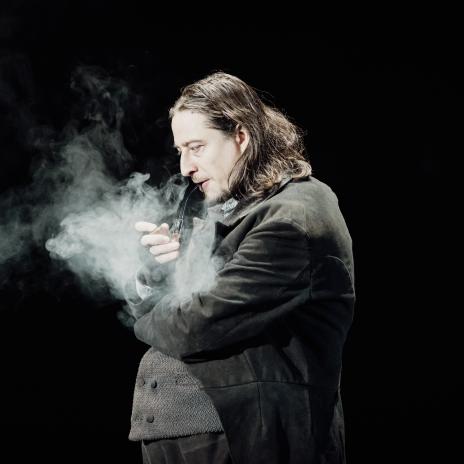
The character of Mephisto was elevated by the hand of Arrigo Boito. He knew his way around diabolical villains: Not only did he translate Der Freischütz into Italian, but he also wrote numerous opera libretti, including Verdi’s Otello with the demonic Iago. In his only completed opera Mefistofele (first version 1868), Boito focussed on Mephisto’s work and failure. In contrast to earlier Faust adaptations, Boito added the Prologue in Heaven, i.e. Mefistofele’s wager with God. Thus, Mefistofele himself is portrayed as driven by the fulfilment of his own contract. For Act IV and the epilogue, Boito used extracts from Goethe’s Faust II (published posthumously in 1832), the continuation of the story after Margarethe’s death. At the end of Mefistofele, Faust is dying and utters the redemptive words: ‘Sacro attimo fuggente, / Arrestati, sei bello! / A me l’eternità!’ (‘Sacred, fleeting moment, / Stop, you are beautiful! / For me eternity!’). In this way, Faust, whose soul goes to heaven, withdraws from Mefistofele’s influence, who is now left empty-handed. What a disappointment for the devil, whose game of seducing people into evil now begins anew!
Devils who fail (comically)
Devils do not always succeed in dragging their victims to hell or keeping them there. Especially not when it comes to the poor devils particularly common in comic operas from the late 19th century onwards. In Antonín Dvořák's Čert a Káča (Kate and the Devil, 1899), all devils are basically quite serious characters – at least if you believe the genre-typical infernal music in Act II, including lots of percussion, chromatic figures and fiery dances. But the heroine Kate, who is ridiculed in the village for her talkativeness, does not care: she does not listen to anyone, not a peasant, not a princess and certainly not a devil. No divine assistance is needed against Dvořák’s opera devils; all that is needed is the decisiveness and self-confidence of a young, independent woman.
Operas like this often draw upon characters from folk tales, legends and popular farces: Dvořák’s opera is based on Božena Němcová’s fairy tale Devil and Káča; Bedřich Smetana’s Čertova stěna (The Devil’s Wall, 1882) is based on a local legend about a striking rock formation; Ottorino Respighi’s Belfagor (1923) is inspired by Niccolò Machiavelli's 16th-century novella; Jaromír Weinberg’s Švanda dudák (Schwanda the Bagpiper, 1927) is based on an old folk tale that was written down as a drama in 1847. In Franz Schreker’s ‘great magic opera’ Der Schmied von Gent (1932) – also based on a Flemish legend –, religious and secular elements are mixed. Thanks to divine help, the clever blacksmith Smee, who has pledged his soul to the devil in an emergency, is able to ‘send the emissaries, who want to drag him to hell at the end of his term, home miserably battered’. (Albert Gier) It hardly helps that the great Lucifer appears, according to the score, ‘with very complicated percussion’. When Smee arrives at the gates of hell, the devils are so intimidated by the treatment of their colleagues that they send the ‘treacherous blacksmith’ back immediately. He could be a relative of Katja.
Dramatic Exit
When devils disappear into the stage floor, this often happens with full orchestral accompaniment, as the victory over evil needs to be celebrated dramatically! Igor Stravinsky’s The Rake’s Progress (1951) is a musical potpourri with allusions from Monteverdi to Mozart and contemporary jazz music. No wonder the midnight departure of the diabolical Nick Shadow at the end of his term is a prime example of music for operatic villains: staccato funeral march rhythms, piercing string motifs, menacing drum rolls and a thundering bass voice – this is how the devil perishes.
Devils make for marvellously gruesome musical moments, fuel dramatic interpersonal conflicts and repeatedly offer the opportunity to reflect on the role of evil in our world. It is safe to assume that the subject of the wager between a human and the devil will continue to fascinate composers and lead them into temptation for a long time to come.
Hannes Föst
